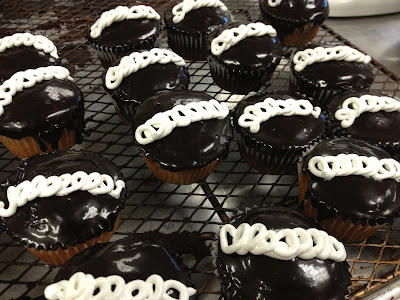Sunday, February 02, 2014
A Dalliance with a Hot Pink French Macaron
Sunday, August 11, 2013
A Sugar High with a Cupcake Cutie
Sunday, March 25, 2012
I’m Old Fashioned

I’ve never seen the Tom Cruise movie “Cocktail” and that’s probably a good thing because I’m an old fashioned kind of guy. That’s why the course “Classic Cocktails,” taught by Anthony Caporale at The Institute of Culinary Education had immediate appeal for me.

Imagine a Saturday night “getting wet.” Don’t worry – it’s a bartending term that aptly describes the action behind the bar. As Caporale says, when you’re mixing cocktails it’s inevitable that things are going to get wet and sticky. Caporale has been in the spirits business for years. He’s a high-energy instructor with a high proof mix of tips, tricks and fascinating anecdotes about the classic cocktail. I’ve already taken his excellent course on Whiskey, Bourbon and Scotch. You can get a taste of his approach at his Art of the Drink website.

Did you know the art of the cocktail emerged during Prohibition? Yes, folks started drinking more because alcohol was illegal, and they started adding things like fruit juice and bitters to mask the taste of some pretty poor quality booze. Fortunately, our tastes and techniques have evolved and mixing cocktails has become an art. Within minutes, Caporale provides the basics on colorless and brown spirits along with a couple of dashes of history and economics, and then gets us started on pouring techniques. Skilled bartenders don’t measure – they count and pour. With a proper pour spout and the right technique, you pour a ½ ounce of liquor per second.
Our source material for the course is six basic cocktail recipes found in David Embury’s “The Fine Art Of Mixing Drinks,” a bartending Bible first published in 1948. Embury was a pioneer in the field of cocktail culture. Caporale adds a modern twist. He’s got a degree in engineering so he’s very good at breaking recipes down into components so you understand the formula, technique and the approach instead of obsessing over a specific recipe. As he explains it, every cocktail starts with a base spirit, and then a combination of mixers, sweetened liquors, fortified wines, or sweet and bitter ingredients are added. The key, he says, is balance. He’s not a fan of the super sweet cocktails popularized in recent time in the United States.
We are each positioned at a station equipped with a tin shaker, an array of bar tools and easy access to a lot of ice. Once we get through a few warm up rounds of pouring, mixing and shaking we get to work and shake up a Dry Gin Martini (the only way to go with a Martini):

A Manhattan with Bourbon and Sweet Vermouth:

An Old Fashioned made with Dewers White Label whiskey on the rocks:

A Rum Daiquiri, which is much simpler and tastier than the super sweet blender concoction we often think of:

A Side Car made with Cognac, Triple Sec and lemon:

And, a Jack Rose made with apple “jack” brandy and rosy-colored Grenadine:

The mixing and shaking gets fast and furious at times. So how do I fare? Well, I’ve already hinted that I’m not Tom Cruise. My pouring aim is off at times (you need to get the spirits into the cocktail shaker, not all over your sleeve) and my Manhattan Cocktail, which I’m pretty experienced at preparing, comes out a bit watered down. But, my Dry Gin Martini is sublime, and I think I’ve discovered a new favorite in the Side Car.
Cheers to Anthony Caporale for shaking up a spirited evening of insider techniques and classic cocktail lore!

©2012 T.W. Barritt All Rights Reserved

























